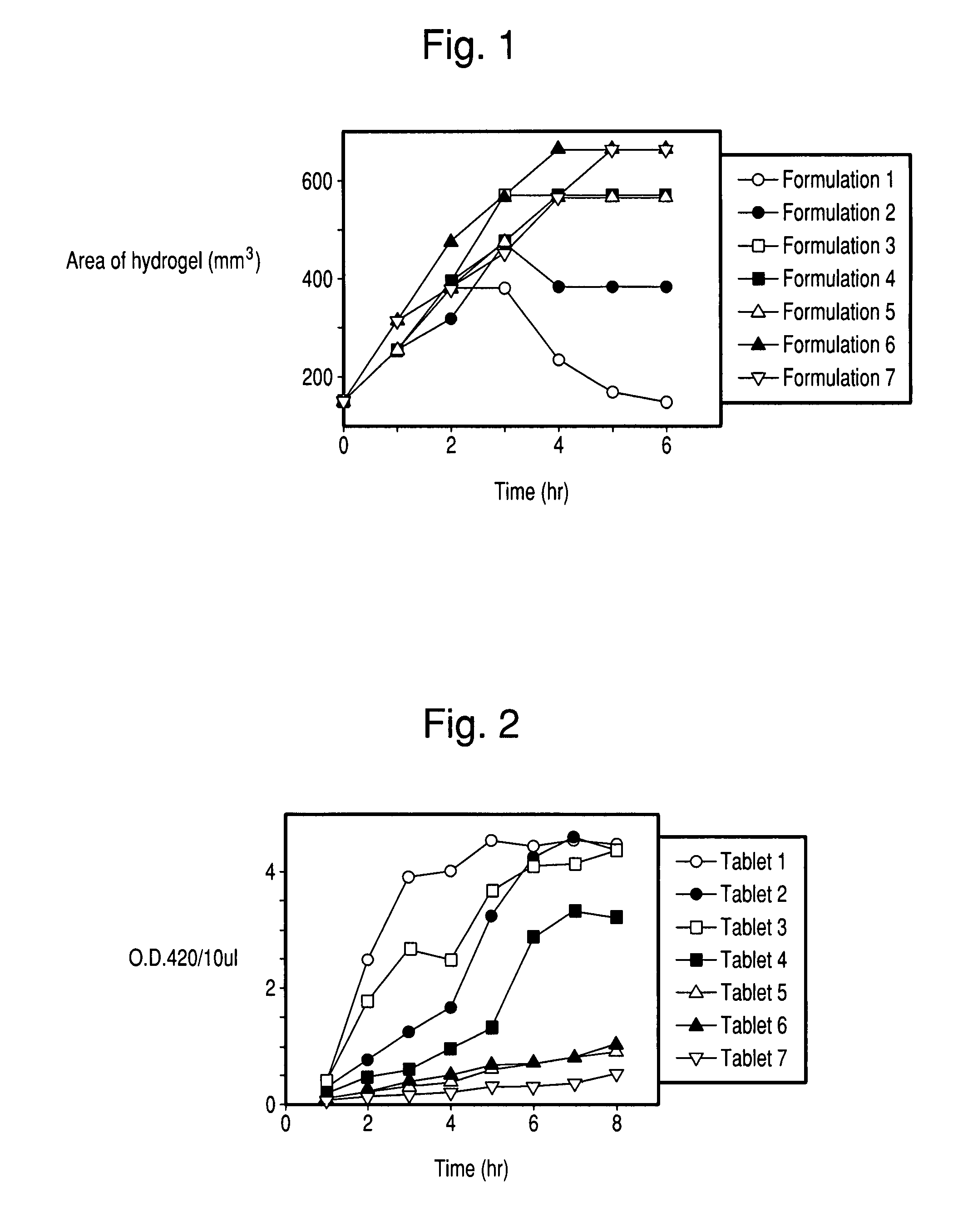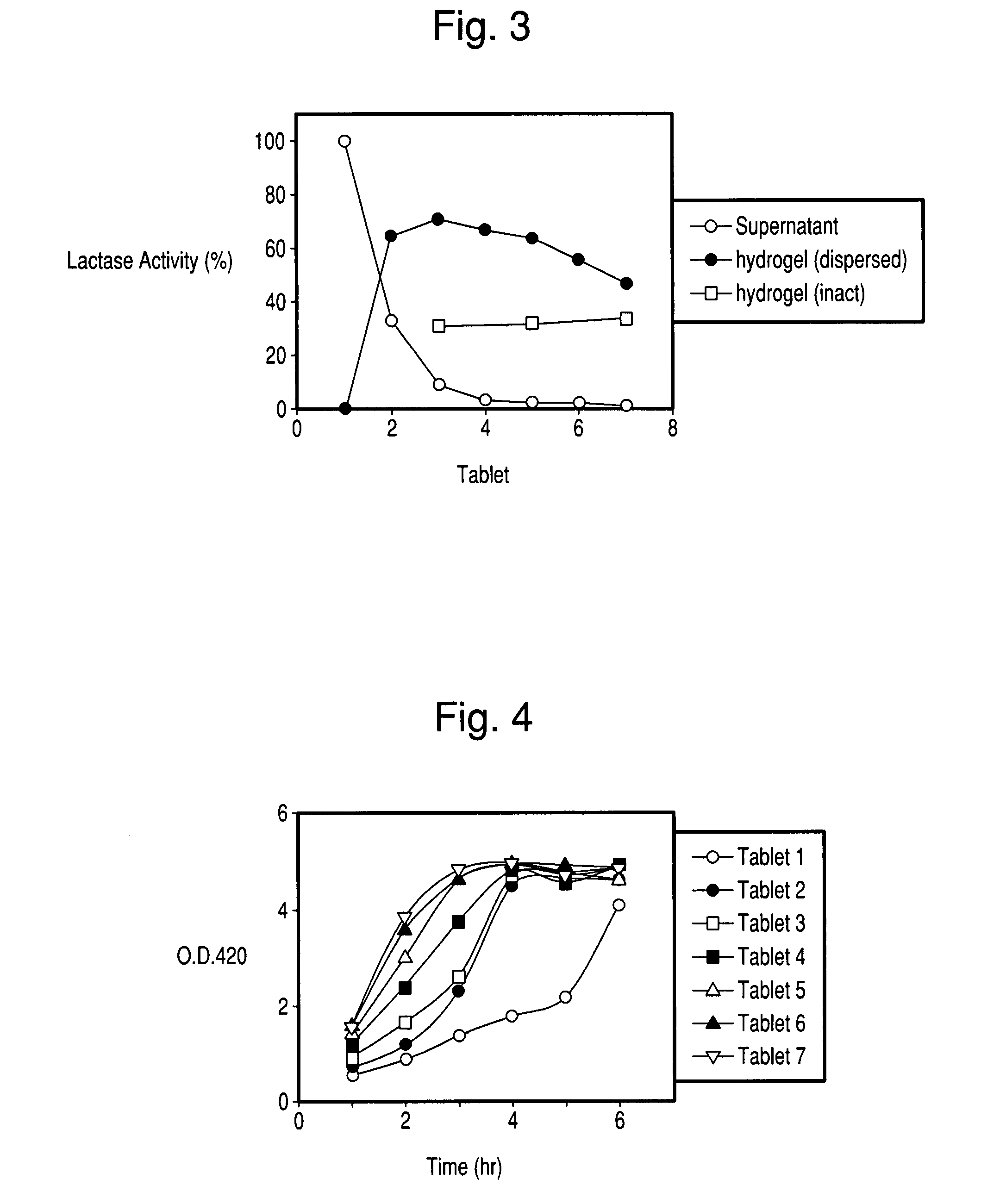Controlled release formulations of enzymes, microorganisms, and antibodies with mucoadhesive polymers
a technology of mucoadhesive polymer and enzyme, which is applied in the field of controlled release formulations of enzymes, microorganisms, and antibodies with mucoadhesive polymers, can solve the problems of not addressing situations where drugs, mucous surface, and none of these enzyme formulations, however, address the need, and achieve the effect of preventing the digestion of carbohydrates and facilitating digestion
- Summary
- Abstract
- Description
- Claims
- Application Information
AI Technical Summary
Benefits of technology
Problems solved by technology
Method used
Image
Examples
example 1
Tablet Hydration
[0080] Each tablet was placed in a plastic weight boat with 20 ml of pre-warmed PBS buffer (37° C.; pH 7.2) and floated on the surface of a 37° C. water bath. At the hourly intervals indicated in FIG. 1, the buffer was removed and the size of the tablet was measured. After measurement, 20 ml of pre-warmed PBS buffer was added and the weight boat was again placed on the surface of the water bath.
[0081] As shown in FIG. 1, Formulation 1 swelled initially and then gradually dissolved. Formulations 2-7 show an increase in volume with formulations containing the most polycarbophil (tablets 6 and 7) swelling up to 7 times the original volume of the tablet. The tablets containing polycarbophil form hydrogel structures that are stable for more than 24 hours.
example 2
Lactase Release
[0082] Formulations and tablets corresponding to Formulations 1-7 were prepared with 100 mg of Lactase DS per tablet. One tablet of each formulation was placed into a 50 ml conical tube with 10 ml of PBS buffer (pH 7.2) and incubated at 37.5° C. At the hourly time intervals indicated in FIG. 2, 10 μl was removed and assayed for lactase activity using the FCCIV assay procedure for lactase (Institute of Medicine, Food Chemicals Codex, Fourth Edition, National Academy Press, Washington, D.C., 1996).
[0083]FIG. 2 shows that the release of lactase from Formulation 1 was rapid and complete within 2 hours. Release of lactase from formulations 2-7 decreased with increasing concentrations of polycarbophil. The time that lactase release from formulations 2-4 was observed increased to 6 hours.
example 3
Lactase Distribution
[0084] Lactase tablets with Formulation 1-7 were placed one tablet each into 50 ml conical tubes with 5 ml of PBS buffer. The tubes were incubated for 16 hours at 37.5° C. The supernatant was removed from each tube and assayed for lactase activity. The remaining hydrogel was washed with 3×5 ml of PBS buffer and then disrupted in 5 ml of PBS buffer and the suspension was assayed for lactase. Since the tablet with Formulation 1 dissolved completely, the lactase activity in the tube with Formulation 1 was taken to be 100% of the lactase activity in the tablets.
[0085] The distributions of lactase activity, either released to the buffer or retained in the hydrogel, is presented in FIG. 3. It is seen that the amount of lactase released into the buffer decreased significantly with the amount of polycarbophil in the tablet (as noted above, the amount of lactase released from tablet 1 is taken as 100%). Conversely, the amount of lactase immobilized within the hydrogel i...
PUM
| Property | Measurement | Unit |
|---|---|---|
| size | aaaaa | aaaaa |
| size | aaaaa | aaaaa |
| size | aaaaa | aaaaa |
Abstract
Description
Claims
Application Information
 Login to View More
Login to View More - R&D
- Intellectual Property
- Life Sciences
- Materials
- Tech Scout
- Unparalleled Data Quality
- Higher Quality Content
- 60% Fewer Hallucinations
Browse by: Latest US Patents, China's latest patents, Technical Efficacy Thesaurus, Application Domain, Technology Topic, Popular Technical Reports.
© 2025 PatSnap. All rights reserved.Legal|Privacy policy|Modern Slavery Act Transparency Statement|Sitemap|About US| Contact US: help@patsnap.com



